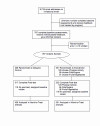Development of Alive! (A Lifestyle Intervention Via Email), and its effect on health-related quality of life, presenteeism, and other behavioral outcomes: randomized controlled trial
- PMID: 19019818
- PMCID: PMC2629370
- DOI: 10.2196/jmir.1112
Development of Alive! (A Lifestyle Intervention Via Email), and its effect on health-related quality of life, presenteeism, and other behavioral outcomes: randomized controlled trial
Abstract
Background: Cost-effective interventions to improve diet and physical activity are a public health priority. Alive! is an email-based intervention to increase physical activity, reduce saturated and trans fats and added sugars, and increase fruit and vegetable consumption. It was shown to improve these behaviors in a large randomized controlled trial.
Objective: (1) To describe the components and behavioral principles underlying Alive!, and (2) to report effects of the intervention on the secondary outcomes: health-related quality of life, presenteeism, self-efficacy, and stage of change.
Methods: The Alive! behavior change model is designed to elicit healthy behaviors and promote their maintenance. Behavioral strategies include assessments followed by individualized feedback, weekly goal-setting, individually tailored goals and tips, reminders, and promotion of social support. Alive! was tested among non-medical employees of Kaiser Permanente of Northern California, who were randomized to either the intervention group or the wait-list control group. After randomization, intervention group participants chose one topic to undertake for the intervention period: increasing physical activity, increasing fruits and vegetables, or decreasing saturated and trans fats and added sugars. Pre-post questionnaires assessed changes in SF-8 health-related quality of life, presenteeism, self-efficacy, and stage of change. Mixed effects multiple linear regression and ordinal logistic regression models were used, with department as a random effect factor. Analyses were by intention to treat: the 30% (238/787) who did not respond to the follow-up questionnaires were assigned change scores of zero.
Results: Participants were 19 to 65 years (mean 44.0 +/- 10.6), and 74.3% (585/787) were female. Mean SF-8 Physical quality of life score increased significantly more in the intervention group than in the control group, 1.84 (95% CI 0.96-2.72) vs 0.72 (95% CI -0.15-1.58) respectively, P = .02. SF8 Mental score also improved significantly more in the intervention group than in the control group (P = .02). The odds ratio for improvement in self-assessed health status was 1.57 (95% CI 1.21-2.04, P < .001) for the intervention group compared to the control group. The odds ratio for having a reduction in difficulty accomplishing work tasks because of physical or emotional problems, a measure of presenteeism, was 1.47 (95% CI 1.05-2.05, P = .02) for the intervention group compared to the control group. The odds of having an improvement in self-efficacy for changing diet was 2.05 (95% CI 1.44-2.93) for the intervention vs the control group (P < .001). Greater improvement in stage of change for physical activity (P = .05), fats (P = .06), and fruits/vegetables (P = .006) was seen in the intervention group compared to the control group. Significant effects on diet and physical activity behavior change are reported elsewhere.
Conclusions: Cost-effective methods that can reach large populations with science-based interventions are urgently needed. Alive! is a fully automated low-cost intervention shown to effect significant improvements in important health parameters.
Trial registration: Clinicaltrials.gov NCT00607009; http://clinicaltrials.gov/ct2/show/NCT00607009 (Archived by WebCite at http://www.webcitation.org/5cLpCWcT6).
Conflict of interest statement
GB, CB, and TB are co-owners of NutritionQuest, which holds the copyright on
Figures
References
-
- Leavitt MO. Physical Activity and Good Nutrition. [2008 Oct 27];Essential elements to prevent chronic diseases and obesity. Centers for Disease Control and Prevention, CCHP, 2007. 5cD2mUrSC http://www.cdc.gov/nccdphp/publications/aag/dnpa.htm.
-
- Stampfer MJ, Hu FB, Manson JE, Rimm EB, Willett WC. Primary prevention of coronary heart disease in women through diet and lifestyle. N Engl J Med. 2000;343:16–22. - PubMed
-
- World Cancer Research Fund / American Institute for Cancer Research, authors. Food, Nutrition, Physical Activity, and the Prevention of Cancer: a Global Perspective. Washington, DC: AICR; 2007.
-
- Landis S H, Murray T, Bolden S, Wingo P A. Cancer statistics, 1999. CA Cancer J Clin. 1999;49(1):8–31, 1. doi: 10.3322/canjclin.49.1.8. http://caonline.amcancersoc.org/cgi/pmidlookup?view=long&pmid=10200775 - DOI - PubMed
Publication types
MeSH terms
Associated data
Grants and funding
LinkOut - more resources
Full Text Sources
Medical




